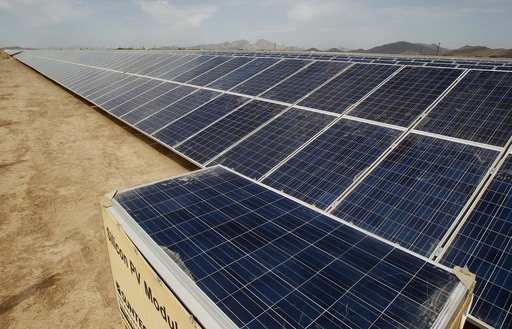PHOENIX (AP) — About 1.4 million customers in Arizona will be paying more for electricity now that regulators have approved a rate hike proposed by the state’s largest utility, and an extra fee for customers with rooftop solar systems is prompting more criticism.
The average monthly bill for Arizona Public Service Co. residential customers will increase by about $10 to $12 starting in March, and those with solar panels will be on the hook for an extra $2.50 to $3 per month under the changes adopted by the Arizona Corporation Commission following an hourslong hearing Thursday.
A few dozen people spoke during the meeting and more than 2,000 people had submitted written comments over the months leading up to the decision.
Commission Chair Jim O’Connor told reporters Friday that he and three Republican colleagues approved the new rate plan without knowing the exact impact it would have on customers since it was projected to be “in the ballpark” of about 8%. O’Connor reasoned that the margin of error was too small to delay voting for another day.
Arizona Public Interest Research Group Education Fund is requesting the commission reconsider the approval and require utility executives to appear before the commission and declare under oath the exact projected impact of the rate hike for all classes of customers.
“Comprehensive data should be entered into the docket, and APS executives should be sworn in before they speak,” Diane Brown wrote in her appeal for the nonprofit group. “The commission failed to ask the questions necessary to ensure they had adequate and complete data before voting on the entire rate plan.”
Parties in the rate case — which began nearly two years ago — have include labor unions, citizens groups, renewable energy advocates and public schools.
Utility officials have said that the rate increase is necessary to ensure reliable and resilient service to customers who live in 11 of the state’s 15 counties. The increase is aimed at helping the utility recoup expenses it incurred in prior years to expand infrastructure.
The increase provides the utility with a return on equity of 9.55%, the Arizona Republic reported. APS President Ted Geisler has argued that a return of at least that much was needed to reassure creditors and lenders on whom APS relies, as the utility’s credit rating and profitability have faltered.
“We need immediate and sufficient rate relief,” Geisler said. “We must continue to rely on lenders to fund the grid investments necessary.”
Commissioner Anna Tovar, a Democrat, cast the lone dissenting vote. She said she couldn’t “support something that costs customers more.”
Commissioner Lea Marquez-Peterson also expressed hesitation but voted in favor of the rate plan, saying it was critical for APS to be able to make infrastructure investments.
Michael O’Donnell, a vice president at Sunsolar Solutions in Peoria, wrote in a note to The Republic that it was “truly outrageous” that the commission would come up with a new charge targeting only solar customers that neither the utility nor any other party in the case had asked for.
He said customers with solar panels have been paying about $80 per month on average to be connected to the grid. He estimated the same customer might be paying $120 a month for the same service after the rate increases.
The utility has said that solar customers don’t pay the full costs of service provided to them, with those costs overwhelmingly focused on transmission lines, generating stations and other infrastructure, not the actual energy produced. An even larger solar surcharge was adopted less than a decade ago by a prior commission but was revoked in 2021.
The rate structure approved this week will have different effects for different classes of customers, such as schools and small businesses. The commission has asked for the utility to submit a written updated analysis, and the commission’s own staff is working on finalizing data.



